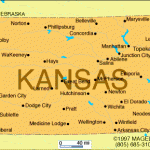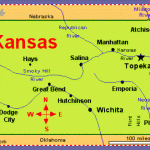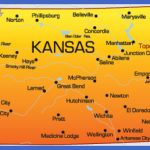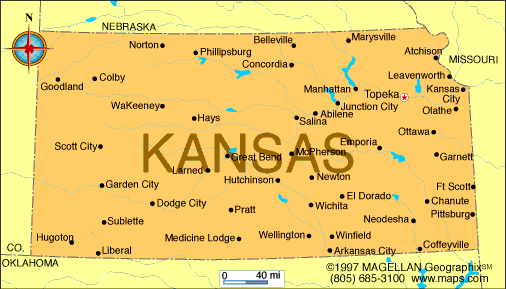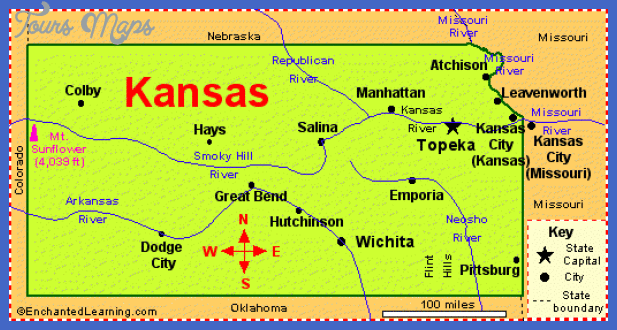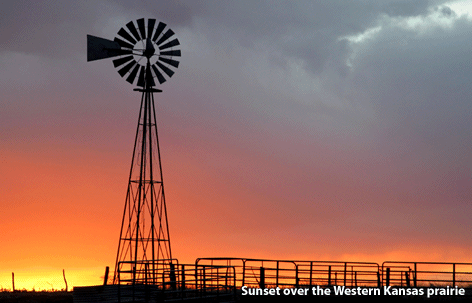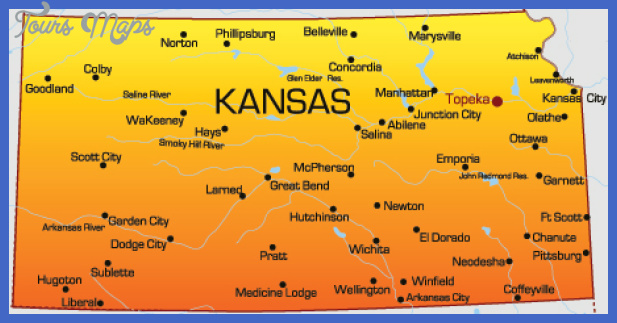Kansas chronology
1541 Spanish conquistador Francisco Vazquez de Coronado and his troop
enter Kansas, searching for the Pueblo Indian village Las Humanas, also known as Gran Quivira, thus starting Spanish involvement with Kansas.
1601 Juan de Onate, governor of Spanish New Mexico, leads an expedition to Kansas.
1682 French explorer Robert LaSalle claims the land along the Mississippi
River and its tributaries for France.
1720 The Pedro de Villasur expedition leaves Santa Fe and crosses Kansas to attack a Pawnee village allied with France. The expedition is defeated by the Pawnees.
1762 Spain acquires Kansas as part of the transfer of Louisiana from French to Spanish control.
1800 Louisiana and Kansas return to French control through a secret treaty between Napoleon and the King of Spain.
1803 France sells Kansas, as part of the Louisiana Purchase, to the United States.
1806 Facundo Melgares leads a Spanish expedition from New Mexico across
Kansas to establish trade with Indians and to contest U.S. claims to the lands west of the Mississippi.
1821 The William Becknell expedition, from Missouri, reaches Santa Fe, New
Mexico, and opens the Santa Fe Trail between Kansas City and Mexican Santa Fe.
President Abraham Lincoln signs the Pacific Railroad Bill, leading to massive building of railroads in Kansas.
Beginning of the heyday of cattle drives from Texas to Kansas railheads, which depended on Latino vaqueros and survive in the folk song Corrido de Kiansis.
Garden City Sugar Beet Company is founded and hires Mexicans to work in its large holdings of sugar beet fields in southwestern Kansas and in its beet processing factory. This leads to the foundation of a Latino colonia (colony) in Garden City.
The Atcheson, Topeka, and Santa Fe Railway, along with other rail companies, actively recruits Mexican labor. The arrival of Mexican workers to Kansas prompts the establishing of Latino communities in every Kansas railroad town.
Anglo parents in Emerson, Kansas, demand segregated schooling for Mexican students, which leads to the education of Latino children in school basements in Kansas.
Clara Barton School, a public institution for Mexican children, opens in Argentine, Kansas, on the demand of Anglo parents for segregated education.
Two hundred Anglo parents encircle the Major Hudson School in Kansas City, Kansas, to demand that four Mexican boys, who had been admitted, be removed from the school. This incident contributed to segregated elementary education for Latinos in Kansas.
1925 Saturnino Alvarado and other Kansas City parents begin a fight for their children to be admitted into Kansas City high schools when the Alvarado children and others are denied admission to 9th grade at the Argentine High School.
1926 Luz Alvarado, Jesus Alvarado, Marcos de Leon, and Victorina Perez are admitted to Argentine High School.
1930 Luz Alvarado, Jesus Alvarado, and Marcos de Leon become the first darker-skinned Latinos to graduate from Argentine High School.
1942 Treaty between Mexico and the United States establishes the Bracero program, which leads to new migration to Kansas.
1970 First publication of the newspaper Aztlan de Leavenworth in the Leavenworth Federal Penitentiary with the poet Raul R. Salinas as editor. Salinas also composed the important Chicano poem Un Trip through the Mind Jail while at Leavenworth.
1971 Formation of the Association of Mexican American Students later Movimiento Estudiantil Chicano de Aztlan (MEChA), and then Hispanic American Leadership Organization (HALO) at the University of Kansas.
1973 Paul Feleciano is elected to the Kansas state legislature.
1974 The Kansas Advisory Committee on Mexican American Affairs is founded by Kansas governor Robert Bennett. Its name was subsequently changed to Kansas Hispanic and Latino American Affairs Commission.
1975 El Centro Inc., the largest Latino service organization in Kansas, is founded.
1976 Paul Feleciano is elected to the Kansas state Senate.
1977 The Hispanic Chamber of Commerce of Greater Kansas City is founded by 25 Latino business leaders.
1987 The Kansas Advisory Committee on Hispanic affairs is founded by the Kansas state government. This organization later became the Kansas Hispanic and Latino American Affairs Commission.
2004 Governor Janet Sebelius signs into law legislation that enables illegal migrants who had graduated from Kansas high schools to pay in-state tuition, without being asked their immigration status.
Delia Garcia becomes the first Latina elected to the Kansas state legislature.
2007 Kansas governor Kathleen Sebelius signs HB 2140, the law that makes
English the official language of Kansas, thereby requiring state agencies to carry out official business in English with limited exceptions.
Kansas Photo Gallery
Maybe You Like Them Too
- The Best Cities To Visit in The World
- World’s 10 Best Places To Visit
- Coolest Countries in the World to Visit
- Travel to Santorini, Greece
- Map of Barbados – Holiday in Barbados

